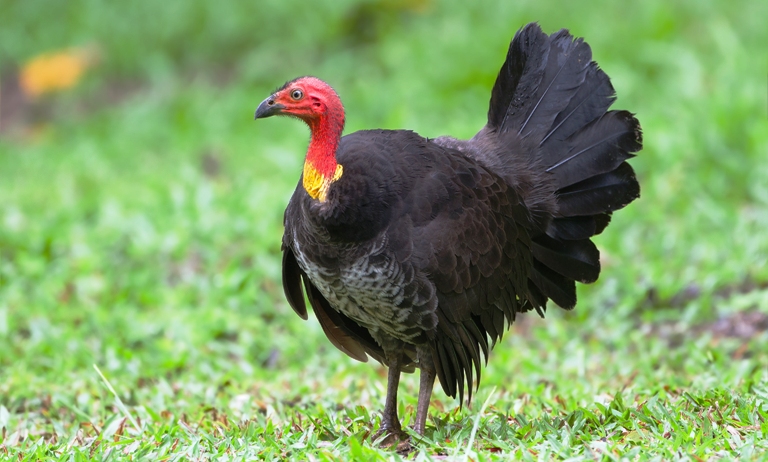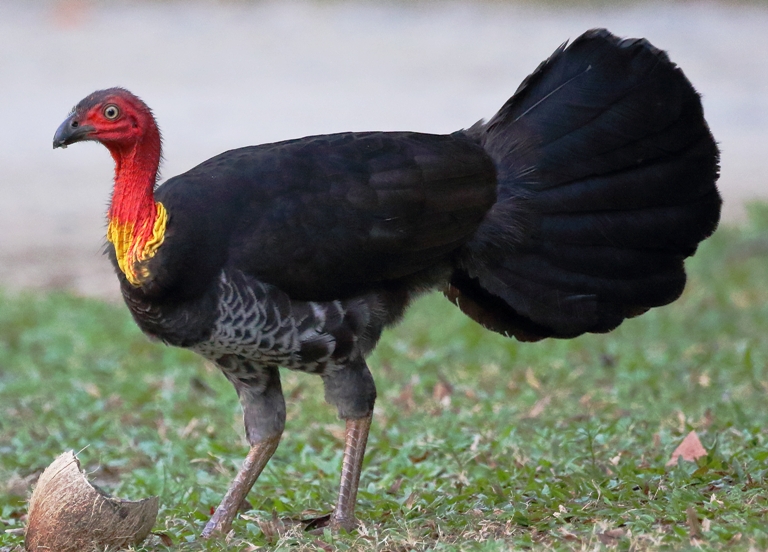Here’re below some interesting facts about Australian brushturkey.
Description – The Australian brushturkey is loosely social. The males build and defend incubation mounds. Roosts communally in trees. The northern range of brush turkey is mainly found at higher altitudes but migrates a short distance in winter. Birds of this species are commonly found in urban environments such as backyards in Sydney and Brisbane.
Measurement – The bird is 23.6-27.6 inches (60-70 cm); females weigh 4.4-5.5 lbs (1.98-2.51 kg), males 4.6-6.4 lbs (2.12–2.9 kg). This is a large turkey, mainly black, a ground-dwelling bird with a bright red head and neck, and males with either yellow or light purple extendable neck sac during the breeding season. Furthermore, the chicks are born fully feathered, with a uniform shade of buff-brown to sooty brown, similar to quails.

Distribution – The range of Australian brush turkey is east Australia, from Cape York to northern New South Wales approximately the area around Wollongong.
Habitats – The bird is mostly found in rainforest and wet sclerophyll forests. It is also found in dry scrub, gardens, and open areas. The bird’s underparts are sprinkled with white feathers, more pronounced in mature birds.
Diet and Feeding Ecology – The Australian brush turkey is a generalist ground-forager, feeding on leaf-litter invertebrates and fruits. The fearless brush turkeys exhibit bold attempts to steal food from tables and raid compost bins in gardens.
Reproductive Biology – Mounds were constructed in July and are maintained until about December. Males are polygynous, maintaining mounds (often two) in which females lay several eggs before moving to another mound. Up to 18–24 eggs; white and elliptical; are laid by each female although a mound may have incubated up to 50 by the end of the season. The young turkeys are extremely social.
Significance to Humans – The eggs of brushturkeys usually weigh 180-190 g. However, they are also a favorite food item for snakes, goannas, dingoes, and dogs, but brushturkeys are also a staple for Aboriginal Australians. The Australian brush turkey can be aggressive in search of food, racking the garden and even damaging food crops.

Australian brush turkey is the largest extant representative of the family Megapodiidae and is one of three species to inhabit Australia. Do not confuse this bird with American turkeys or Australian bustards, as both are also recognized as bush turkeys. As Mallefowl, Waigeo brushturkey, and Wattled brushturkey are the closest relatives.
Flight – A clumsy flyer doesn’t have the ability to fly long distances. The turkey only takes air flight when threatened by predators or roosts in trees at night and during the heat of the day.
Taxonomy – Alectura lathami Gray, 1831, Sydney, Australia. Two subspecies were recognized.
Other Names – English: Scrub turkey, bush turkey, pouched talegallus; French: Talégalle de Latham; German: Bruschhuhn; Spanish: Talégalo Cabecirrojo.
Nest – Nests are built in suburban gardens so they can search for material for their shelter and remove an enormous amount of mulch from gardens. The male builds the nest on the ground relentlessly and collects material from all directions vigilantly.
The clutch contains 18 to 25 eggs of white color, sometimes more than 50 eggs laid by several females. The young fledge within an hour once their feathers are dried. The bird usually uses the same nesting site frequently used year after year, with the old nests being upgraded for each breeding season.
Status – The turkey is mainly abundant and locally common throughout most of its range, especially in southern Queensland where it is often a nuisance in urban gardens. It has also been introduced to Kangaroo Island in South Australia. In the 1930s the bird nearly became extinct, but now its population is stable. Read More – Ground Hornbill







